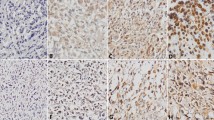Abstract
Objective
To evaluate X-linked inhibitor of apoptosis protein (XIAP) expression in biopsy specimens from the patients with stage IIB osteosarcomas before chemotherapy to study XIAP expression and its predictive significance of prognosis in stage IIB osteosarcomas.
Methods
The expression of XIAP was retrospectively detected by SP immunohistochemistry in 31 cases biopsy specimens from stage IIB osteosarcomas before chemotherapy, and the relationship between XIAP expression and clinicopathologic features of the patients with stage IIB osteosarcomas was analyzed.
Results
The osteosarcoma specimens showed strong cell nucleus immunoreaction of XIAP while normal bone specimens showed weak. High XIAP positive expression independently predicted the patient’s poor outcome and had no relationship with clinicopathologic variables such as age, gender, location, tumor size, rate of tumor necrosis to preoperative chemotherapy, local recurrence (P > 0.05). Significant correlations were found between high XIAP expression and metastasis (P = 0.022), and also between high XIAP expression and final survival (P = 0.011).
Conclusion
XIAP plays an important role in the development of stage IIB osteosarcomas and XIAP expression of biopsy specimens before chemotherapy can be seen as a promising prognostic marker in early predicting the outcome of patients suffering from stage IIB osteosarcomas.
Similar content being viewed by others
References
Eckelman BP, Salvesen GS, Scott FL. Human inhibitor of apoptosis proteins: why XIAP is the black sheep of the family. EMBO Rep, 2006, 7: 988–994.
Liu JH, Li M, Xia SJ. Expression and clinical significance of antiapoptosis gene XIAP in prostate cancer. Nat J Androl (Chinese), 2004, 10: 832–835.
Li M, Song T, Yin ZF, et al. XIAP as a prognostic marker of early recurrence of nonmuscular invasive bladder cancer. Chin Med J, 2007, 120: 469–473.
Qin YM, Auh S, Blokh L, et al. TNF-α induces transient resistance to Fas-induced apoptosis in eosinophilic acute myeloid leukemia cells. Cell Mol Immunol, 2007, 4: 43–52.
Jian ZY, Li YX, Lu XG, et al. Expression of X-linked inhibitor of apoptosis in pancreatic carcinoma tissues and its relationship to chemoresistance. Chin J Digest (Chinese), 2006, 26: 76–79.
Meyers PA, Heller G, Healey J, et al. Chemotherapy for nonmetastatic osteogenic sarcoma: the Memorial Sloan-Kettering experience. J Clin Oncol, 1992, 10: 5–15.
Kim MS, Song WS, Cho WH, et al. Ezrin expression predicts survival in stage IIB osteosarcomas. Clin Orthop Relat Res, 2007, 459: 229–236.
Meyers PA, Schwartz CL, Krailo M, et al. Osteosarcoma: a randomized, prospective trail of the addition of ifosfamide and/or muramyl tripeptide to cisplatin, doxorubicin, and high-dose methotrexate. J Clin Oncol, 2005, 23: 2004–2011.
Hornicek FJ, Gebhardt MC, Wolfe MW, et al. P-glycoprotein levels predict poor outcome in patients with osteosarcoma. Clin Orthop Relat Res, 2000, 373: 11–17.
Onda M, Matsuda S, Higaki S, et al. ErbB-2 expression is correlated with poor prognosis for patients with osteosarcoma. Cancer, 1996, 77: 71–78.
Serra M, Scotlandi K, Reverter-Branchat G, et al. Value of P-glycoprotein and clinicopathologic factors as the basis for new treatment strategies in high-grade osteosarcoma of the extremities. J Clin Oncol, 2003, 21: 536–542.
Woodhouse EC, Chuaqui RF, Liotta LA. General mechanisms of metastasis. Cancer, 1997, 80: 1529–1537.
Yang YF, Zhang GM, Xu ZH, et al. Repair of massive bone defects in limbs by using vascularized free fibular autograft compounding massive bone allografts. Chin J Repar Recons Surg (Chinese), 2005, 19: 986–988.
Yang YF, Zhang GM, XU ZH, et al. Structural bone allografts with intramedullary vascularized fibular autografts for the treatment of massive bone defects in extremities. J Med Coll PLA, 2007, 22: 298–302.
Author information
Authors and Affiliations
Corresponding author
Additional information
Supported by a grant from the Foundation for Scientific Research of Medical Science of Guangzhou (No. 2006-YB-017).
Rights and permissions
About this article
Cite this article
Yang, Y., Du, H., Huang, P. et al. XIAP expression and its predictive significance of prognosis in stage IIB osteosarcomas. Chin. -Ger. J. Clin. Oncol. 7, 416–419 (2008). https://doi.org/10.1007/s10330-008-0024-0
Received:
Revised:
Accepted:
Published:
Issue Date:
DOI: https://doi.org/10.1007/s10330-008-0024-0




